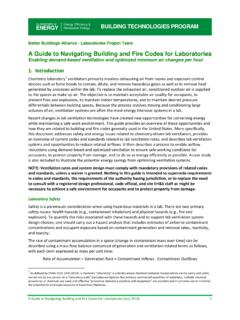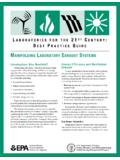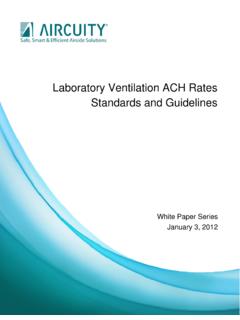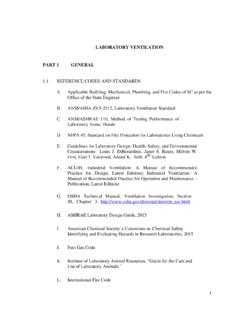Transcription of Laboratories for the 21st Century: Best Practice Guide
1 Department of EnergyEnergy Efficiency and Renewable EnergyFederal Energy Management ProgramUnited StatesEnvironmentalProtection AgencyLaboratories for the 21st Century: Best Practice GuideCOMMISSIONING VENTILATED CONTAINMENT SYSTEMS IN THE LABORATORYC over photos: courtesy of Laconic Corporation, Kansas City, MOIntroductionVentilated containment equipment has commonly been delivered and installed as off-the-shelf selections, consid-ered state of the art by default if not by superior design. However, with advancing technology of ventilated contain-ment systems (VCS) and with heightened concern over material hazards, environmental protection, and energy conservation, equipment efficacy must be assured. Consequently, commissioning has become an essential discipline for the effective construction and operation of laboratory facilities. Additionally, a well-implemented commissioning plan can help pave the way to Leadership in Energy and Environmental Design (LEED) certification, as established by the Green Building concept of commissioning has been shaped over time by design teams to fit their particular time, place, and set of needs.
2 It has been viewed as any set of inspection and testing activities somewhere between planning and end-use LABS FOR THE 21st CENTURY2operations. To provide an operational definition: Commissioning is everything you do to make certain that you get the performance you asked for in a given facility design. This Best Practice Guide does not cover comprehen-sive building commissioning, but focuses on the special-ized approaches required for VCS, understood to be all components that drive and control ventilated enclosures and local exhaust systems within the laboratory. The sys-tem typically begins with the dampers that modulate air supplied to the laboratory and ends at the top of the exhaust stack. Everything in between is considered part of this system: supply-air diffusers, ventilated enclosures, exhaust valves, fans, controls and algorithms, and related items integral to this equipment. Many resources exist for understanding and imple-menting commissioning activities (see References and Resources).
3 This Guide is one in a series of best practices for Laboratories produced by Laboratories for the 21st century ( Labs 21 ), a joint program of the Environmental Protection Agency (EPA) and the Department of Energy (DOE). Geared toward architects, engineers, and facility managers, these guides provide information about technologies and practices to use in designing, constructing, and operating safe, sustainable, high-performance Laboratories . A Spectrum of Ventilated Containment EquipmentThe contemporary laboratory may be a simple instal-lation of one ventilated enclosure or may contain multi-ples of the entire range of containment devices in use today: Fume hoods Custom ventilated enclosures Articulated arm exhausts Balance enclosures Downdraft tables Slotted backdraft hoods Biological safety cabinets Gloveboxes and glovebags Canopy hoods Each device has multiple types designed for a specific purpose with specific performance criteria that can only be determined by those familiar with the characteristics of the materials and the operation.
4 Ideally, each device type will be tested individually and as it interacts with other equipment in the system. This customized complexity is the primary reason that VCS commissioning must begin with the design Together Essential PersonnelIt is unlikely to find a single commissioning company that has all the expertise necessary for coordinating com-prehensive building commissioning and that is also skilled with the intricacies of VCS commissioning. Creating a multidisciplinary team with experience in engineering design, construction, and facility operations is essential. The initial commissioning team should combine the archi-tectural and enginering (A&E) firm with in-house staff, forming a group that embraces all the needed talents. This core team can put together the initial plan, turning to a larger group for review and feedback. Consider including these resources:Internal staff: End users Engineering Health, safety, and environmental Project management MaintenanceExternal Staff A&E firm Commissioning agent Testing consultantsSeveral key parties can be identified later: the equip-ment manufacturers and vendors, general contractors and their subcontractors, and the testing, adjusting and balanc-ing (TAB) contractors; however, based on past experience the commissioning agent and testing agents should be hired early on.
5 The commissioning firm should be experi-enced in laboratory building startup, and the testing con-sultants must have documented experience with the specialized equipment and knowledge required to be pro-ficient with VCS. Interviews help to evaluate verbal and people skills, but should be backed up by references and work samples. Commissioning and/or testing agents may be from internal staff, but it is rare to have staff with broad experience in VCS commissioning. The prospective testing consultant should fully com-prehend equipment design: the aerodynamics of ventilat-ed enclosures, including airfoils and baffles, the subtle effects of shape on airflow patterns, and air-supply modifi-cations such as auxiliary air, bypass grilles, and supply dif-fusers. The consultant must understand safety, quality, and environmental equipment options and how they affect the commissioning protocol, including the benefits and disad-vantages of variable air volume (VAV) compared to con-stant air volume (CAV) air supply and exhaust.
6 Another option is with exhaust systems, where manifold systems can reduce costs, conserve energy, and increase safety. The LABS FOR THE 21st CENTURY3intent document. A detailed design document reflects agreements among all parties as to the valid requirements of the project that will shape later commissioning: equipment choices, such as the design opening of hoods, and performance criteria, such as average face velocity, speed of response, stability, and containment. User needs, safety/risk assessments, and environmental and energy performance requirements all fit into the mix, expressed in a set of construction drawings, a bidding package, and a well-defined commissioning plan. 1) User needs. Many laboratory applications can appear to require highly customized ventilated enclosures and systems. These drive up facility costs and should be justified by a safety/risk analysis. Most laboratory con-tainment requirements are accommodated by standard manufacturers models with an array of options.
7 If a cus-tom design is genuinely required, detailed commissioning requirements for the item must be part of the design pro-cess. Other user requirements affecting commissioning include air cleanliness and temperature and humidity lim-its. Where exhaust filtration is required, criteria must be established early for appropriate filter specification and commissioning requirements. 2) Safety/risk. First, determine the nature of the risks to be managed, whether chemical, biological, or physical. Some hazards require specialized rooms, ventilation sys-tems, or life-safety systems; and commissioning for excep-tionally hazardous materials may need substance-specific monitoring during equipment operation. If exposure lim-its do not exist to determine pass/fail criteria, reasonable criteria must be established so that the manufacturer has a target to aim for. This type of testing may be expensive and should be prescribed judiciously.
8 Testing with consultant should be conversant with testing standards: face velocity range, criteria for flow visualization, and tracer gas or particle-counting challenges. Particularly, the consultant should be able to discuss the variables of static vs. dynamic conditions, sash positions, and test duration. The consultant should be able to extrapolate from these standard fume hood tests to recommend procedures for other ventilated enclosures. Key Elements of the Commissioning PlanA commissioning plan that begins in the earliest stag-es of a project leads to an orderly and effective succession of events. A complete plan identifies all equipment and systems requiring commissioning, with performance test-ing methods to be used for each component, along with parameters for acceptable performance. The documenta-tion will include these items: All equipment submittals required to support the commissioning process Requirements for training of the operations and maintenance personnel Expected owner/user manuals Requirements for process sequence and system operation manuals Sample formats for reports and other documentation A detailed schedule for when various commissioning operations will occurCommissioning within the Phases of a ProjectIn the broadest strokes we can discuss the progress of a sound commissioning plan during a three-stage timeline: Design, Deliver, and Sustain.
9 Design. End-users, A&E firms, industrial hygiene and safety personnel, engineers, and management should all be included in the design stage. This first phase will result in a formalized expression of a facility concept, which should be manifested in a design profile or a design Photo courtesy of Tintschl Engineering, Erlangen, GermanyFigure 1. A large custom enclosure requires specialized commissioning for LEEDThe commissioning plan can also facilitate LEED certification. The LEED prerequisite fundamental building systems commissioning mandates specific steps that exemplify a good commissioning plan even when certification is not planned. The LEED program offers additional credit for Enhanced Commissioning for in-depth oversight during the design and submittal process to catch potential problems. Check for details. LABS FOR THE 21st CENTURY4surrogates (such as sulfur hexafluoride) should be done whenever possible, but safety-critical operations may require actual operational data collected by a continuous monitoring system.
10 The best designed ventilated enclosures are still dependent for their effectiveness on the environment in which they are installed. A containment and ventilation system is designed based on a projected interaction of a number of personnel using specific equipment and operat-ing in concert with a correctly designed air-handling sys-tem. The number of people in a room often determines the number of ventilated enclosures per room, which in turn determines the total airflow required. Depending on the extent of containment required and the types of ventilated enclosures used, excessive air changes can make attaining the containment criteria impossible, calling for a change in basic assumptions of building size or population. Reliance on incorrect containment criteria leaves the project suscep-tible to extensive failures and cost corollary of the airflow volume is velocity, a surpris-ingly overlooked design factor.



















